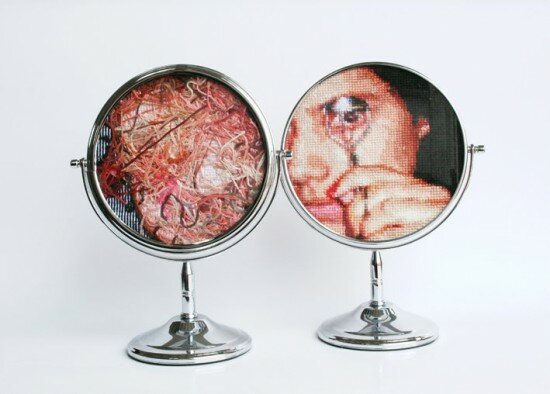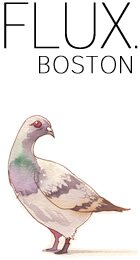I have always loved the following observation by philosopher, Arthur Schopenhauer:
“Life may be compared to a piece of embroidery of which, during the first half of our time, we get a sight of the right side, and during the second half, of the wrong. The wrong side is not as pretty…but it is more instructive; it shows the way in which the threads have been worked together.”
He’s right. Not only does this embroidery concept pertain to life itself, but it can also be related to the curatorial process(or any large undertaking, really). While it has been amazing to celebrate Pedigree, the polished result of 7 months of hard work, it is just as important for me to reflect on the process, thread clumps and all, that brought us from inception to unveiling.
——————————
Stress Mess
(Ana Teresa Barboza)
Now that the last eye portrait has been safely stowed away, I have finally had a chance to enjoy my first unlabored breath in months. Putting a show together is stressful. There are no two ways about it. Some stress is good, the kind that lights a fire under you. Some stress is bad, the kind that just..lights you on fire.
And both seem to battle for equal stage time, so it’s important to figure out how to manage these stressors.
Maybe this is a good start?:
Planning
Planning certainly helps with alleviating some of that aforementioned stress. From my experience, the earlier you start work on an exhibition, the better. However, in the 11th hour, no matter how much you plan, shit goes awry unexpected circumstances may arise. An artist gets sick during install, a piece intended for show is lost in the postal service, price list numbers don’t seem to match with the map, the gallery burns to the ground in freak accident, etc. This phenomenon was recently described to me as simply, “magic” and “leaving room for magic to happen”.
Which is fine. I do love a dash of bibbidi-bobbidi-boo in my life, but it can be unnerving when things feel unfinished days/hours before the opening. But I suppose at some point near the finish line you have to surrender to a sense of blind trust because you can’t control everything. Know that the months leading up to the reveal, and the countless hours of hard work were not for naught, and that things have a tendency of mysteriously falling into place. And if they don’t? Reach for a glass of wine.
Planning Tips:
(Ana Teresa Barboza)
Google Docs– Maintain a spreadsheet that contains pertinent information related to the exhibition including artist names, titles of included work(medium, size, price..), installation dates, de-installation dates and a checklist of important documents(loan consignment agreements, resumes, etc). You’ll thank my later.
And having this information online means 1.) you can access it from any computer and 2.) you can easily share it with the gallery to make sure everyone is in the loop.
Paper calendar– Kill a tree. As long as you don’t lose it, I find physical calendars to be organizational lifesavers. You can jot down important dates, meetings, notes in the margin and tuck it into your moleskin. For some reason, despite all the techie things I do, I find it nice to have a tangible crumpled calendar handy.
Pinterest– I used Pinterest to help organize and select some of the images and artists for Pedigree and it was also handy when considering aesthetic cohesion among the 14 artists. I layered in desired work with inspirational images and was able to share this board with others so they could get a better feel for the theme, curatorial direction, and related works in the show.
Floor Plans– (A MUST.) Having gallery dimensions handy is priceless, so grab a copy of the floorplan. This will prove extremely helpful when considering layout and enables you to create a (general) plan of attack prior to arriving on installation day. Many museums even create 3-D foam core dioramas of the gallery space when they are installing work. And I guess you could do that too..if you’re an OVERACHIEVER.
Taming the Wild Beast
Pedigree was the first time I was asked to write a formal proposal for an exhibition. And while it was initially difficult for me to put my wild and scattered thoughts down on paper, I quickly understood the value in creating a proposal for just that very reason. Learning how to concisely articulate a vision. If you are pulling together a group show that has some sort of “theme” element, it is important to figure out exactly what you are trying to “say” through your work, and consider the appropriateness of the included artists. Basically, “How does this artist’s work enhance an understanding of the theme?” When you start looping everything back to the umbrella topic, you quickly realize that even though you may love an artist, their work might not be a great fit for the show. And you have to be strong enough to set them aside for another day (square peg. round hole.). Otherwise, the desired cohesiveness of your exhibition may fall to pieces and you’re left with “just another group show”.
Tough Love and Safeguarding Your Vision
At this point, I have had countless difficult conversations in the arts. And I don’t necessarily mean with difficult people(although there have been a few, tee hee), but difficult as in conversations that call for immediate decisiveness; you often find yourself making a quick decision while your heart is still in your throat. “Am I doing the right thing?” “Does this make sense?” “What if this looks bad?” It’s as if your mind becomes a whirring-microprocessor weighing the pros and cons of an action and calculating all possible outcome in real time, often with someone standing in front of you AND you probably haven’t slept in a week. LOL. (see also: Managing Stress)
In order to bring a project to life the way you intended you sometimes have to be ruthless and hold fast to your beliefs. Try not to overanalyze, because sometimes over-analysis leads to paralysis. Run with it, trust your gut instinct. Not every decision is going to please everyone and if you start changing things around to appease others(or the naysayer in your head) you will find that the uniqueness of the original concept quickly becomes a shell of it’s former self.
Basically, RULE WITH AN IRON FIST.
BUT, Be Open.
You won’t have all the answers. And some people, especially those with knowledge in related and complementary fields, can actually help you fill in the missing pieces or shed light(literally) on a direction that you hadn’t previously considered.
Storytime: The evening before the Pedigree reception, when the show was 99% installed, a local lighting specialist stopped by the gallery to discuss the pros and cons of various configurations with me. He felt as though some aspects of the existing layout might not hold up when lit due to bulb locations and the overall structure of the New Art Center. The thought of shuffling things around made me want to die, but from our conversation I agreed that some light tweaking was in order. And it was for the best. And the show was properly lit. And the villagers rejoiced.
Lean on Me, and I’ll Lean on You
Over the past few months, the staff at the New Art Center have truly felt like family. We laughed together, we “:(“ed together, and we celebrated over beers together. I cannot stress enough that Pedigree was the result of MANY MANY individuals; a complete team effort. The NAC was kind enough to provide the support I needed to bring my dream to fruition; anything from crawling through the ceiling to install a hoof chandelier, to slapping peanut butter and jelly on finger sandwiches minutes before the opening. I am extremely thankful that they trusted me to execute my wild vision in their home.
Postpartem
It’s sad to have it all end. Seeing pieces removed from any show is a bit heart-wrenching. It’s worse than empty walls. At least a blank slate symbolizes new beginnings, whereas a partially de-installed exhibit makes me want to frantically tear down the remaining work, box it all up, ship it off as quickly as possible..and then hit the pub.
I’m just no good at goodbyes.
But I’ve also come to realize that this comes with the territory. If I want to continue to curate, I can’t just seal the gallery doors and entomb an exhibition forever just because I like it. Change is good. Pedigree came, saw, conquered and now it is time to celebrate a new curator’s vision. Because everyone deserves to feel how I did about Pedigree.
Thank you x ∞ to the New Art Center, the artists, the press, my loved ones(two legged and four legged) and YOU for coming along with me on this journey.
There will always be a blue ribbon by my bedside. ♥














